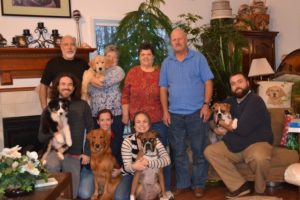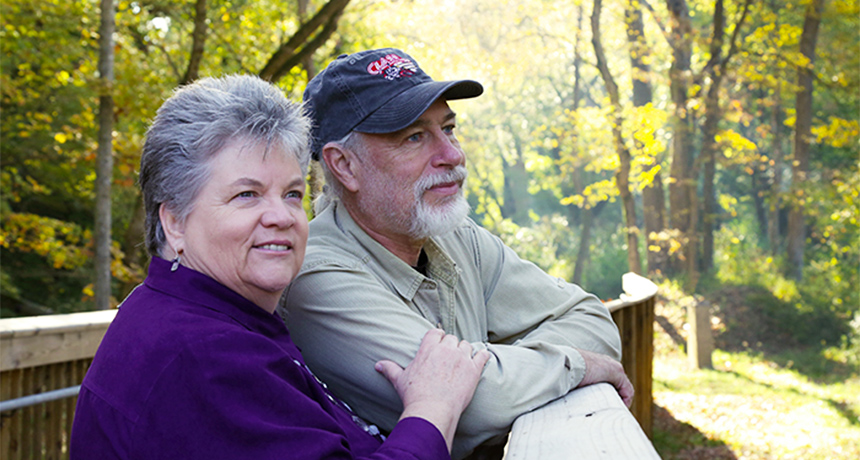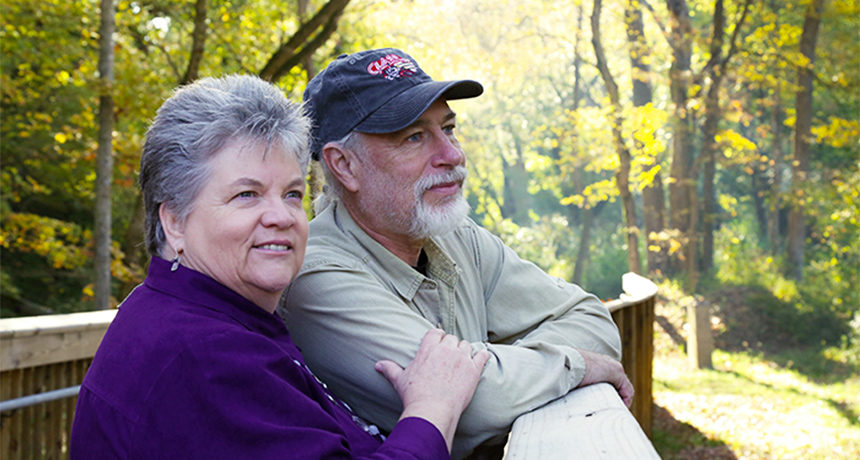Carol Fowler Durham, a nurse educator at the UNC School of Nursing, nearly died from septic shock. Today she shares her experiences with audiences around the country and serves as an important weapon for UNC Medical Center’s sepsis reduction initiative, Code Sepsis.
Five years ago, on the Monday after Thanksgiving, Carol Fowler Durham, PhD, EdD, RN, was at a faculty meeting at the UNC School of Nursing, where she teaches and directs the simulation program, when she began to shiver.

“It was rigors—I was shaking very hard,” remembers Carol, who had missed work earlier in the month for treatment of an abscess. “In my infinite wisdom, even though my friends and colleagues, who are all nurses, were nearby, and the hospital was only a few steps away, I decided to go home, to Hillsborough, to take care of myself.”
Carol thought that if she sought refuge on the couch, with the company of her dogs, Bright-Eye and Brixx, she would feel better. But her discomfort only intensified, and it wasn’t long before she began projectile vomiting, having diarrhea, and experiencing a strange, unsettling feeling.
“A sense of impending doom suddenly came over me,” she says. “I knew that whatever this was, it was serious, and that something terrible was going to happen. As a nurse educator, I teach about that feeling a lot—the sense of dread. I teach students to be aware of it in their patients. But to have it is really frightening.”
Sepsis
Carol called her husband, Stephen, who was an IT specialist for the Department of Transportation in Raleigh. Stephen quickly left his office and rushed home. She also called her daughter, Rebecca, who was working nearby as a veterinary technician, and asked her to leave work because she was afraid she might worsen before Stephen could arrive home.
When Stephen reached the house around 4 p.m., they immediately went to the Emergency Department (ED) at UNC Medical Center in Chapel Hill. It was a busy day in the ED. Carol waited, and eventually was taken back for evaluation. Using an IV, they pumped her with fluids and started antibiotics. They asked her to pee in a cup but she couldn’t produce any urine.
“I thought, ‘This doesn’t make any sense,’” she recalls. “‘I’ve been drinking and had fluids yet I can’t pee.’ The fact that I could not urinate and had an elevated temperature got me admitted into the hospital.”
After admission Monday night, Carol’s condition continued to deteriorate. Her heart rate and respiratory rate was rising, her blood pressure was dropping, and the sense of doom persisted.
Early Tuesday morning, Cindy Johnson, RN, the nurse manager on the floor, came in to assess her. Cindy recognized Carol was in trouble and called Janice Galloway, RN, of the Adult Rapid Response Team (AART) at UNC Hospitals, for a consultation.
“Janice arrived, introduced herself, and said, ‘You’re my project today,’” Carol says. “It was a frightening thought to realize I needed a rapid response nurse, but at the same time, I was so relieved that one was there to help.”
Janice closely monitored Carol, while Stephen, their son, Brandon, and family friends were in the room. Brandon, a vegetarian who eats well and takes care of himself, looked at his mom and said, “Mom, I’ve been doing research, and I’ve found that if you have an infection, organic orange juice is good for you, so I brought you a half-gallon, as well as some breakfast.”
Three months earlier, Carol had done a module on sepsis for her nursing students and had suspected that’s what she was experiencing. Sepsis occurs within the body when it is fighting infection. Instead of fighting the virus or bacteria causing the infection, the body produces a toxic reaction, sending white blood cells to attack tissues and organs. The results can be devastating: death, cognitive damage, and deterioration in physical functioning. Carol knew that the outcomes weren’t good but she didn’t want to worry her family with her self-diagnosis.
“Here I am looking at my sweet son, realizing that he might not have another interaction with me because of sepsis,” she says. “I didn’t feel like drinking or eating, but I didn’t want him to think that I wasn’t trying, so I sipped some of the juice and nibbled on the breakfast he had brought.”
“She was my lifeline. She looked me in the eye and I knew she had me.”
Time went by, and Carol still wasn’t producing urine. Janice’s gut told her that she needed to bring in other ARRT team members and that Carol needed to be moved to another unit for even closer observation. She called the team, and a few minutes later, a crash cart showed up with emergency medication and equipment. Physicians soon arrived.
By then it was clear to Carol that sepsis, if indeed that’s what she had, might kill her. She remembers making eye contact with Janice.
“She was my lifeline,” says Carol. “She looked me in the eye and I knew she had me.”
Carol asked one of the physicians in the room what worried him most about her condition—she often teaches nursing students to think about the worst case scenario for the patient and she wanted to find out what the physicians were thinking.
“He hesitated and seemed uncertain about how to best answer this poignant question,” Carol says.
She pressed him, telling him that she was a nurse and it would help her to know.
“Septic shock,” he responded.
“As funny as it sounds, I was relieved,” Carol says. “I said, ‘Thank God, because that’s what I think it is too.’ I was so grateful we were all on the same page.”

A Sign
Despite the dangers of sepsis, Carol was comforted when she knew that her care team felt confident in the diagnosis and had been listening to her.
“When a patient is engaged, as I was, and nurses and physicians make space for patient engagement, it’s collaborative, and the patient really does become part of the team,” she says. “That empowers the patient in their own health care, and for me, it was reassuring. There was no doubt in my mind that Janice and the physicians were listening to me and that they were doing everything they needed to do, doing it correctly, and that we were on the same page.”
Janice traveled with Carol to her next observation unit.
“She’d used her diagnostic reasoning skills to figure out the problem,” Carol says. “Had she not been with me after diagnosis, I would have felt very vulnerable without her.”
On her new unit, Carol, who has taught at the UNC School of Nursing for more than three decades, received care from former students and other excellent nurses. Friends asked how she felt about having former students as her caregivers.
“There was no better nurse for me because I know how they were trained, I know they had an excellent education, and UNC nurses are amazing.”
“I was relieved and happy when I looked up and saw familiar faces,” she says. “There was no better nurse for me because I know how they were trained, I know they had an excellent education, and UNC nurses are amazing.”
Administration of treatments, including antibiotics and fluids, were working.
Overnight that Tuesday, a storm came through and a cloud formation resembling a dancing person was visible outside her room.
“That was my sign that I would be okay,” she says. “Faith is important to me and many people were praying for me. I believe we are healed in three ways: first, a true miracle; second, the miracle of health care, where nurses and physicians are the healing hand of God; third, we go to heaven. For me, I was blessed to be healed in the second way.”
‘It would have been too late’
Most patients and their families have never heard of sepsis, which kills more people every year than breast cancer, prostate cancer, and AIDS combined.
“Before this happened, I’d never thought about it,” Stephen says. “I’ve struggled with how much more I should have known. As Carol was fighting it, even though she thought that’s what it might be, she didn’t tell me much other than, ‘I’m glad you’re here to hold my hand,’ as we did things couples do to reaffirm each other in those moments.”
As Stephen sat by Carol’s side, he wrote long emails from his phone to everyone in her nursing and friend circles explaining what was happening and sharing details such as her vital signs and condition.

Looking back at that period of time now, he’s relieved, in a sense, that he didn’t know how serious it was.
“I would have been very, very, very scared,” he says. “Of course, I was deeply worried and concerned, but her alertness kept me reassured, which allowed me to be more helpful to her.”
Still, he wishes that he had known more about sepsis, and he would like to see greater awareness about the condition so that others can recognize its signs.
“We only came to the hospital because Carol is a nurse, is very knowledgeable, and she had this sense of dread,” he says. “In many cases, people may decide, as couples, to sleep on it before going to the ED. If we’d done that, then Carol wouldn’t have gotten treatment until noon on Tuesday, and it would have been too late.”
Raising Awareness
Today, Carol travels around the country and speaks to health-care professionals and nursing students about patient safety, interweaving her experience with sepsis. The response she receives to her story, she says, is overwhelming.
Earlier this fall, Carol was tapped by Ila Mapp, RN, manager of the Adult Specialty Care Team, and Tina Schade Willis, MD, leader of UNC Medical Center’s sepsis reduction initiative, Code Sepsis, to partner with the Code Sepsis implementation team and serve as a patient advisor in the implementation of the program. Additionally, Ila asked Carol to share her story with nurses serving as Code Sepsis leaders on their units.
“Having Carol at the table with our team for implementing this important program is invaluable,” says Dr. Schade Willis, Associate Chief Medical Officer for Quality at UNC Hospitals and a physician in the Pediatric Intensive Care Unit at the North Carolina Children’s Hospital.

At one point in the team’s design of an early warning system that detects patients deteriorating from conditions like sepsis, the group learned what it really meant to have Carol as a member. They were struggling calculating urine production correctly in the early warning system and considered taking it out of the calculation completely.
“Carol spoke up at the perfect time, saying, ‘Please keep the urine in the calculating—it was the sign that indicated that I was in septic shock, and that is important,’” says Dr. Schade Willis. “Her input focused on solving the problem rather than giving up on the possibility, and that one team member’s incredible viewpoint may be responsible for saving the lives of sepsis patients like Carol.”
In October, Code Sepsis implemented the early warning system for nurses and physicians that calculates the likelihood that a patient at UNC Hospitals may be experiencing deterioration due to sepsis or other similar conditions. Today, it serves as complementary tool for caregivers in their diagnoses.
For Carol, participating in Code Sepsis has been an honor.
“I’m a daughter, a sister, a friend, a nurse, a wife, a mother, an educator, and a grandmother to dogs—not children,” says Carol, laughing. “My family and I are so grateful for all that our nurses and physicians do for patients and for the work that’s being done at UNC Medical Center on behalf of patients who are going through—and will go through—what we experienced. Being part of this effort, which blends the critical thinking of our great caregivers with the tools that will help people with sepsis, is a way for me to help others and to give back to our community.”

